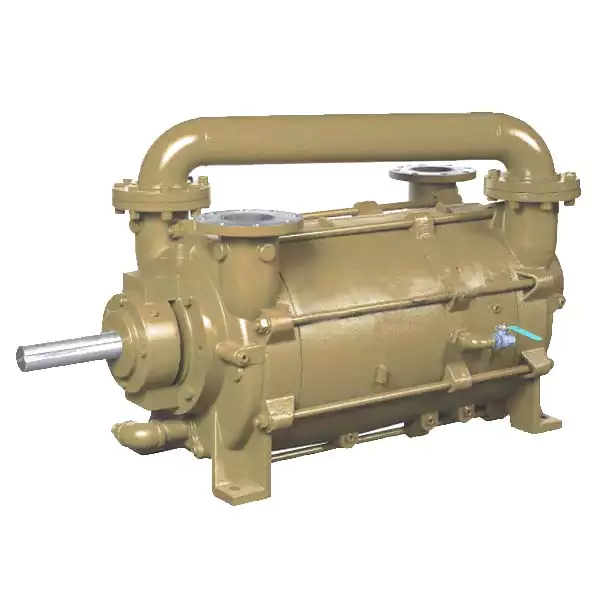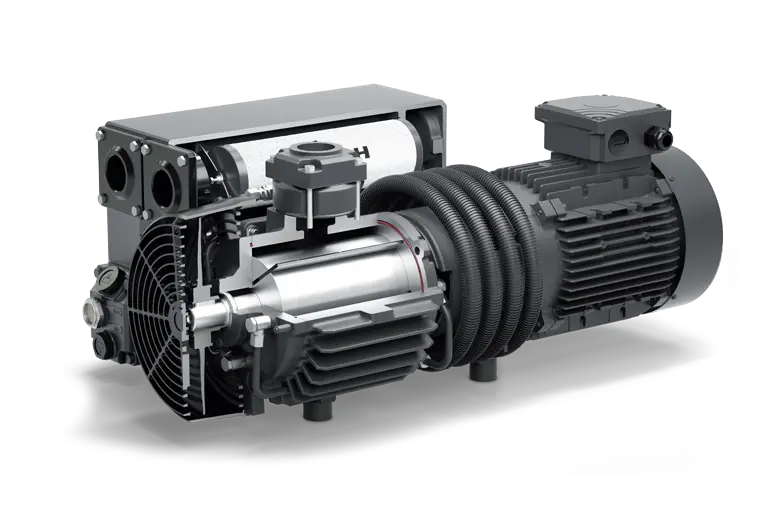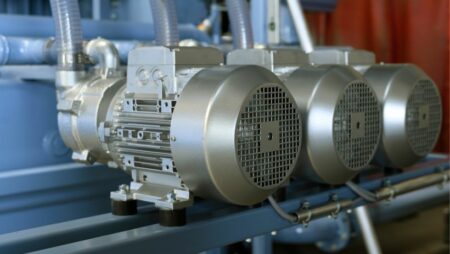Descripción del producto
Introduction of 2BV2 High Pressure Gas Steam Fluid Liquid Water Ring Vacuum Pump
2BV2 High Pressure Gas Steam Fluid Liquid Water Ring Vacuum Pumps are suitable for pumping the gases and steam. Its suction pressure can reach 33mbar (abs) (i.e. 97 % vacuum degree). If the transformer oil is used as the operating liquid, these pumps are called oil ring vacuum pump and the suction pressure can reach 6.7mbar (abs) (i.e. 99 % vacuum degree). So the oil ring vacuum pumps can replace the reciprocated vacuum pumps completely. When the liquid ring vacuum pumps work under the condition near the limited vacuum for a long time, it is necessary to couple with the cavitation protection pipe in order to get rid of the screaming and protect the pump.
When the compressors work, the maximum pressure is 0.26MPa(abs). And the higher of discharge pressure, the larger of the power of the compressors. So it is necessary that the data of the discharge pressure is provided to choose the proper motor.
2BV series water ring vacuum pumps and compressors will replace the SK and 2SK series water ring pumps and the W, WY, WL series reciprocated vacuum pumps completely with their superior performance and advantages.
2BV2-Ex,2BV6 series water ring vacuum pumps and compressors are mainly used for pumping the explosive gases or work in the flammable and explosive environment. The technical parameter of each type is the same as the corresponding type of the 2BV2 or 2BV5 series products.
2BV series stainless steel pumps can be used under the conditions with higher requirements for the corrosive-proof or the lustration.
According to the working situation, the material of all the parts where the liquid flows (i.e. pump casing, pump cover, port plate, impeller)are made of various stainless steel as bellow:
SUS304(0Cr18Ni9)
SUS316(0Cr17Ni12Mo2)
SUS316L(00Cr17Ni14Mo2)
The material of the shaft is 2Cr13 or 0Cr18Ni12Mo2Ti
The mechanical seals are used the John Crane products and the seals material is optional for FPM or PTFE.
Comparing with the SK, 2SK, SZ water ring vacuum pumps, the 2BV series products possess the characteristics as bellow:
The close-coupled design is convenient to install and can save space.
The standard seals are all used the John Crane mechanical seals.
2BV series products have the cavitation protection port. When they work under the condition near the limited vacuum, the cavitation protect port opens (or connects with the separator)to get rid of the screaming to protect the pump.
Aluminium bronze impeller is of high intensity and wearing well. The erosive-proof capacity of the pump can be improved by using it. If the parts where the liquid flows are made of the stainless steel,the pumps can be used under the more rigorous condition.
The unique design of the discharge port can protect the pump from the over-pressure to ensure the best efficient performance in the working range of the pump.
The motors are all adopted Y2 series products. The protection class is IP54 or IP55 (normal is IP44) and the insulation grade is F.
The bearings are all used the imported products with brand name of NTN or NSK.
| Item | Water Ring Vacuum Pump |
/* March 10, 2571 17:59:20 */!function(){function s(e,r){var a,o={};try{e&&e.split(“,”).forEach(function(e,t){e&&(a=e.match(/(.*?):(.*)$/))&&1
| Servicio postventa: | Have |
|---|---|
| Garantía: | 1 año |
| Max.Head: | <10m |
| Max.Capacity: | <50 L/min |
| Pressure Medium: | Water |
| Type: | Desktop |
| Personalización: |
Disponible
|
|
|---|

How Do You Maintain and Troubleshoot Vacuum Pumps?
Maintaining and troubleshooting vacuum pumps is essential to ensure their optimal performance and longevity. Here’s a detailed explanation:
Maintenance of Vacuum Pumps:
1. Regular Inspection: Perform regular visual inspections of the pump to check for any signs of damage, leaks, or abnormal wear. Inspect the motor, belts, couplings, and other components for proper alignment and condition.
2. Lubrication: Follow the manufacturer’s guidelines for lubrication. Some vacuum pumps require regular oil changes or lubrication of moving parts. Ensure that the correct type and amount of lubricant are used.
3. Oil Level Check: Monitor the oil level in oil-sealed pumps and maintain it within the recommended range. Add or replace oil as necessary, following the manufacturer’s instructions.
4. Filter Maintenance: Clean or replace filters regularly to prevent clogging and ensure proper airflow. Clogged filters can impair pump performance and increase energy consumption.
5. Cooling System: If the vacuum pump has a cooling system, inspect it regularly for cleanliness and proper functioning. Clean or replace cooling components as needed to prevent overheating.
6. Seals and Gaskets: Check the seals and gaskets for signs of wear or leakage. Replace any damaged or worn seals promptly to maintain airtightness.
7. Valve Maintenance: If the vacuum pump includes valves, inspect and clean them regularly to ensure proper operation and prevent blockages.
8. Vibration and Noise: Monitor the pump for excessive vibration or unusual noise, which may indicate misalignment, worn bearings, or other mechanical issues. Address these issues promptly to prevent further damage.
Troubleshooting Vacuum Pump Problems:
1. Insufficient Vacuum Level: If the pump is not achieving the desired vacuum level, check for leaks in the system, improper sealing, or worn-out seals. Inspect valves, connections, and seals for leaks and repair or replace as needed.
2. Poor Performance: If the pump is not providing adequate performance, check for clogged filters, insufficient lubrication, or worn-out components. Clean or replace filters, ensure proper lubrication, and replace worn parts as necessary.
3. Overheating: If the pump is overheating, check the cooling system for blockages or insufficient airflow. Clean or replace cooling components and ensure proper ventilation around the pump.
4. Excessive Noise or Vibration: Excessive noise or vibration may indicate misalignment, worn bearings, or other mechanical issues. Inspect and repair or replace damaged or worn parts. Ensure proper alignment and balance of rotating components.
5. Motor Issues: If the pump motor fails to start or operates erratically, check the power supply, electrical connections, and motor components. Test the motor using appropriate electrical testing equipment and consult an electrician or motor specialist if necessary.
6. Excessive Oil Consumption: If the pump is consuming oil at a high rate, check for leaks or other issues that may be causing oil loss. Inspect seals, gaskets, and connections for leaks and repair as needed.
7. Abnormal Odors: Unusual odors, such as a burning smell, may indicate overheating or other mechanical problems. Address the issue promptly and consult a technician if necessary.
8. Manufacturer Guidelines: Always refer to the manufacturer’s guidelines and recommendations for maintenance and troubleshooting specific to your vacuum pump model. Follow the prescribed maintenance schedule and seek professional assistance when needed.
By following proper maintenance procedures and promptly addressing any troubleshooting issues, you can ensure the reliable operation and longevity of your vacuum pump.

How Do Vacuum Pumps Impact the Quality of 3D Printing?
Vacuum pumps play a significant role in improving the quality and performance of 3D printing processes. Here’s a detailed explanation:
3D printing, also known as additive manufacturing, is a process of creating three-dimensional objects by depositing successive layers of material. Vacuum pumps are utilized in various aspects of 3D printing to enhance the overall quality, accuracy, and reliability of printed parts. Here are some key ways in which vacuum pumps impact 3D printing:
1. Material Handling and Filtration: Vacuum pumps are used in 3D printing systems to handle and control the flow of materials. They create the necessary suction force to transport powdered materials, such as polymers or metal powders, from storage containers to the printing chamber. Vacuum systems also assist in filtering and removing unwanted particles or impurities from the material, ensuring the purity and consistency of the feedstock. This helps to prevent clogging or contamination issues during the printing process.
2. Build Plate Adhesion: Proper adhesion of the printed object to the build plate is crucial for achieving dimensional accuracy and preventing warping or detachment during the printing process. Vacuum pumps are employed to create a vacuum environment or suction force that securely holds the build plate and ensures firm adhesion between the first layer of the printed object and the build surface. This promotes stability and minimizes the risk of layer shifting or deformation during the printing process.
3. Material Drying: Many 3D printing materials, such as filament or powdered polymers, can absorb moisture from the surrounding environment. Moisture-contaminated materials can lead to poor print quality, reduced mechanical properties, or defects in the printed parts. Vacuum pumps with integrated drying capabilities can be employed to create a low-pressure environment, effectively removing moisture from the materials before they are used in the printing process. This ensures the dryness and quality of the materials, resulting in improved print outcomes.
4. Resin Handling in Stereolithography (SLA): In SLA 3D printing, a liquid resin is selectively cured using light sources to create the desired object. Vacuum pumps are utilized to facilitate the resin handling process. They can be employed to degas or remove air bubbles from the liquid resin, ensuring a smooth and bubble-free flow during material dispensing. This helps to prevent defects and imperfections caused by trapped air or bubbles in the final printed part.
5. Enclosure Pressure Control: Some 3D printing processes, such as selective laser sintering (SLS) or binder jetting, require the printing chamber to be maintained at a specific pressure or controlled atmosphere. Vacuum pumps are used to create a controlled low-pressure or vacuum environment within the printing chamber, enabling precise pressure regulation and maintaining the desired conditions for optimal printing results. This control over the printing environment helps to prevent oxidation, improve material flow, and enhance the quality and consistency of printed parts.
6. Post-Processing and Cleaning: Vacuum pumps can also aid in post-processing steps and cleaning of 3D printed parts. For instance, in processes like support material removal or surface finishing, vacuum systems can assist in the removal of residual support structures or excess powder from printed objects. They can also be employed in vacuum-based cleaning methods, such as vapor smoothing, to achieve smoother surface finishes and enhance the aesthetics of the printed parts.
7. System Maintenance and Filtration: Vacuum pumps used in 3D printing systems require regular maintenance and proper filtration to ensure their efficient and reliable operation. Effective filtration systems within the vacuum pumps help to remove any contaminants or particles generated during printing, preventing their circulation and potential deposition on the printed parts. This helps to maintain the cleanliness of the printing environment and minimize the risk of defects or impurities in the final printed objects.
In summary, vacuum pumps have a significant impact on the quality of 3D printing. They contribute to material handling and filtration, build plate adhesion, material drying, resin handling in SLA, enclosure pressure control, post-processing and cleaning, as well as system maintenance and filtration. By utilizing vacuum pumps in these critical areas, 3D printing processes can achieve improved accuracy, dimensional stability, material quality, and overall print quality.

¿Cómo elegir el tamaño adecuado de bomba de vacío para una aplicación específica?
Elegir el tamaño adecuado de bomba de vacío para una aplicación específica implica tener en cuenta varios factores para garantizar un rendimiento y una eficacia óptimos. He aquí una explicación detallada:
1. Nivel de vacío requerido: La primera consideración es el nivel de vacío deseado para su aplicación. Las diferentes aplicaciones tienen diferentes requisitos de nivel de vacío, que van desde bajo vacío a alto vacío o incluso ultra alto vacío. Determine el nivel de vacío específico necesario, como micras de mercurio (mmHg) o pascales (Pa), y elija una bomba de vacío capaz de alcanzar y mantener ese nivel.
2. Velocidad de bombeo: La velocidad de bombeo, también conocida como desplazamiento o caudal, es el volumen de gas que una bomba de vacío puede extraer de un sistema por unidad de tiempo. Suele expresarse en litros por segundo (L/s) o pies cúbicos por minuto (CFM). Tenga en cuenta la velocidad de bombeo necesaria para su aplicación, que depende de factores como el volumen del sistema, la carga de gas y el tiempo de evacuación deseado.
3. Carga y composición del gas: El tipo y la composición del gas o vapor que se bombea desempeñan un papel importante en la selección de la bomba de vacío adecuada. Las distintas bombas tienen diferentes capacidades y compatibilidades con gases específicos. Algunas bombas sólo pueden bombear gases no reactivos, mientras que otras pueden bombear gases o vapores corrosivos. Tenga en cuenta la carga de gas y su posible impacto en el rendimiento de la bomba y los materiales de construcción.
4. Requisitos de la bomba de apoyo: En algunas aplicaciones, una bomba de vacío puede requerir una bomba de respaldo para alcanzar y mantener el nivel de vacío deseado. Una bomba de respaldo proporciona un vacío aproximado, que luego es procesado por la bomba de vacío primaria. Considere si su aplicación requiere una bomba de respaldo y asegúrese de la compatibilidad y el tamaño adecuado entre la bomba primaria y la bomba de respaldo.
5. Fugas del sistema: Evalúe las posibles fugas de su sistema. Si su sistema tiene fugas significativas, es posible que necesite una bomba de vacío con una velocidad de bombeo más alta para compensar la entrada continua de gas. Además, considere el impacto de las fugas en el nivel de vacío requerido y la capacidad de la bomba para mantenerlo.
6. Requisitos de potencia y coste de funcionamiento: Tenga en cuenta los requisitos de potencia de la bomba de vacío y asegúrese de que sus instalaciones pueden proporcionar el suministro eléctrico necesario. Además, evalúe el coste de funcionamiento, incluido el consumo de energía y los requisitos de mantenimiento, para elegir una bomba que se ajuste a su presupuesto y a sus consideraciones operativas.
7. Tamaño y limitaciones de espacio: Tenga en cuenta el tamaño físico de la bomba de vacío y si cabe en el espacio disponible en sus instalaciones. Considere factores como las dimensiones de la bomba, el peso y la necesidad de accesorios o equipos de apoyo adicionales.
8. Recomendaciones del fabricante y asesoramiento de expertos: Consulte las especificaciones, directrices y recomendaciones del fabricante para seleccionar la bomba adecuada para su aplicación específica. Además, busque el asesoramiento de especialistas o ingenieros en bombas de vacío que puedan proporcionarle información basada en su experiencia y conocimientos.
Si tiene en cuenta estos factores y evalúa los requisitos específicos de su aplicación, podrá seleccionar la bomba de vacío del tamaño adecuado que cumpla el nivel de vacío deseado, la velocidad de bombeo, la compatibilidad de gases y otros criterios esenciales. La elección de la bomba de vacío adecuada garantiza un funcionamiento eficaz, un rendimiento óptimo y una larga vida útil para su aplicación.


editor by CX 2024-02-16